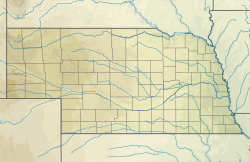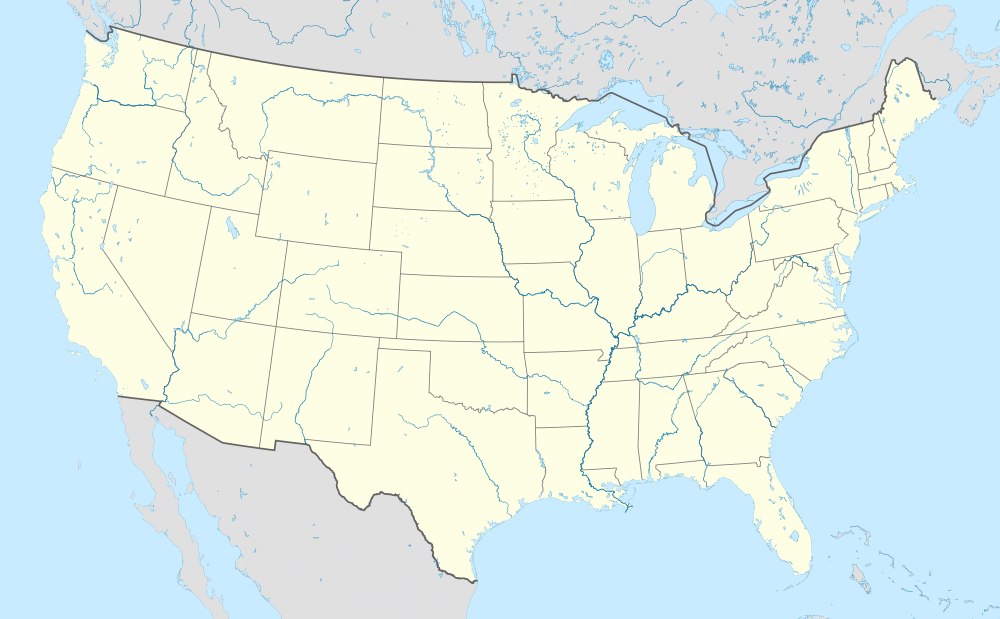Historical airline service
United Airlines provided the first commercial airline service to GRI in the mid-1930s when the airport was added as a stop on United's transcontinental air route between San Francisco and New York. Many other cities were served on this route including Sacramento, Reno, Salt Lake City, Denver, Lincoln, Omaha, Des Moines, Moline, Chicago, Toledo, and Cleveland. United began using Boeing 247 aircraft and later upgraded with Douglas DC-3s and Convair 340s. Service continued until 1959 when Frontier Airlines took over. [5]
Frontier Airlines (1950-1986) began serving GRI in 1959 on a route between Denver and Kansas City which made stops at Cheyenne, Scottsbluff, North Platte, Grand Island, Lincoln, Omaha, and St. Joseph. The carrier began service with Convair 340 aircraft and upgraded to Convair 580s by the mid-1960s. In 1970 Frontier introduced Boeing 737-200 jet service to GRI with direct flights to Denver and Omaha and occasional direct service was provided to Chicago, Kansas City, Dallas/Fort Worth, Phoenix, and Las Vegas. Frontier's jet service ended in 1984 and was replaced by Frontier Commuter using Convair 580s but all service ended in early 1985. [6]
From the late 1970s through the 2000s GRI received service from a series of smaller commuter airlines. Several of these carriers operated on behalf of major airlines such as United Express and Continental Express. After 1990, only one carrier at a time served GRI as service to the airport became subsidized under the federal Essential Air Service program in which a certain carrier is awarded such service.
Air Wisconsin served GRI on two occasions; 1979-1981 with a route to Minneapolis making a stop in Lincoln using Fairchild Swearingen Metroliners and 1985-1986 with a route to Chicago O'hare International Airport also making a stop at Lincoln using BAC One-Eleven jets. [7]
Air Nebraska, 1980-1981, with a Kearney - Grand Island - Omaha - Kansas City route using an Embraer EMB 110 Bandeirante.
Pioneer Airlines served GRI from 1983 through 1986 operating on behalf of Continental Airlines as Continental Commuter. The carrier flew to Denver and Omaha with stops at cities throughout Nebraska and used Beechcraft Model 99 and Fairchild Swearingen Metroliner aircraft.
Rocky Mountain Airways began service in 1985 along the Denver - Scottsbluff - North Platte - Grand Island - Lincoln - Omaha route, otherwise known as the River Route, as it mostly serves cities along the Platte River. Rocky Mountain began a code-share alliance with Continental Airlines in 1986 and operated as Continental Express before ending service in 1987. The carrier used de Havilland Dash 7 aircraft.
Air Midwest began service in 1982 with routes to Lincoln, Omaha, and Kansas City using Fairchild Swearingen Metroliners. In 1986 the carrier began operating as Eastern Express on behalf of Eastern Airlines and in 1988 Air Midwest switched their alliance to Braniff Airways operating as Braniff Express. A Saab 340 aircraft was used for a time while flying as Eastern Express. Service ended in 1989.
Midcontinent Airlines began service in 1986 with flights to Kansas City and Omaha. In 1987 the carrier also began operating as Braniff Express alongside Air Midwest. Midcontinent used Embraer EMB 110 Bandeirante and Fairchild Swearingen Metroliner aircraft. After the collapse of Braniff in 1989, Midcontinent flew under its own identity to Kansas City before ending service in 1990.
GP Express Airlines was headquartered in Grand Island and began service in 1987 along the river route after Rocky Mountain/Continental Express ended their service. Flights to Kansas City and Minneapolis were added in 1990 and the carrier began a code-share alliance with Continental Airlines in 1994 operating as Continental Connection. GP Express used Beechcraft Model 99 and Beechcraft 1900C aircraft. The carrier shut down in 1996.
Great Lakes Airlines began GRI service in 1996 after the collapse of GP Express. Great lakes operated as United Express on behalf of United Airlines using Beechcraft 1900D aircraft. Direct service was provided to Denver, Chicago, Minneapolis, and Omaha. Great Lakes lost its designation as United Express in 2002 but continued service under its own branding until 2006.
Air Midwest returned to GRI operating as US Airways Express on behalf of US Airways via a code sharing agreement. The carrier commenced service on October 29, 2006 with two daily flights to Omaha Eppley Airfield and one daily flight to Kansas City International Airport. Air Midwest ended their service in May 2008, and local commuter air carrier Island Air then announced plans to take over but did not begin this new replacement service.
GRI then went for a period of time in 2008 with no service. Great Lakes Airlines returned in 2009 with flights to Denver which continued until the current provider, American Eagle, began service in 2011. [8]
American Eagle, operating on behalf of American Airlines, began serving GRI on June 9, 2011 with two daily flights to DFW using Embraer 145 regional jets. At times a third flight was added and larger jets including the CRJ-700 and CRJ-900s have been used.
Allegiant Air began service in 2008 with flights to Las Vegas and later added flights to the Phoenix-Mesa Gateway Airport. During 2016 flights were briefly added to Orlando Sanford International Airport. Typically, flights run on two days per week. Allegiant started service with McDonnell Douglas MD-80 jets and now operates Airbus A319s and Airbus A320s.



